We all know the story of Lucia and the traditions of Christmas in Sweden-many we carry on in our own homes each year. But it's fun to revisit the story and reminisce about Swedish Christmases.
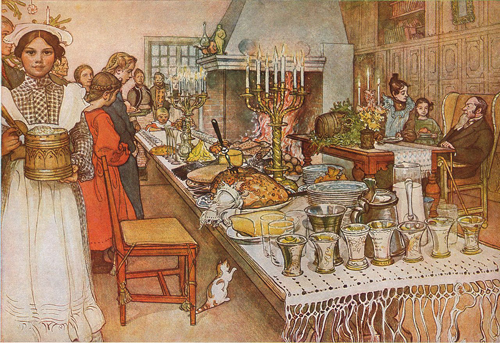
Julaftonen (Christmas Eve) by Carl Larsson in 1904
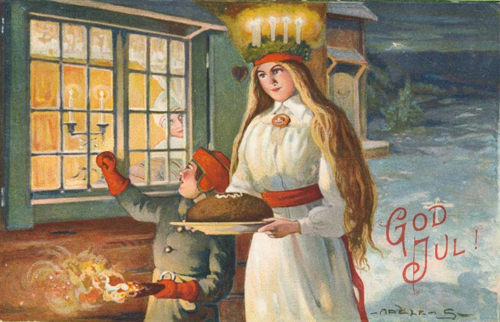
1916 Swedish Christmas card with Lucia in the snowSt. Lucia's Day is now celebrated by a girl in a white dress with a red sash round her waist and a crown of candles on her head. Small children use electric candles but from about 12 years old, real candles are often used! The crown is made of Lingonberry branches which are evergreen and symbolize new life in winter. Schools normally have their own St. Lucias and some towns and villages also choose a girl to play St. Lucia in a procession where carols are sung.
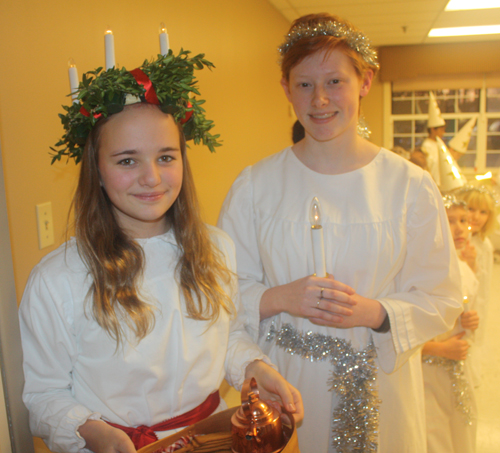
Santa Lucia ceremony in Cleveland
A popular food eaten on St. Lucia's Day are 'Lussekatts', St. Lucia's Day buns flavored with saffron and dotted with raisins which are eaten for breakfast.
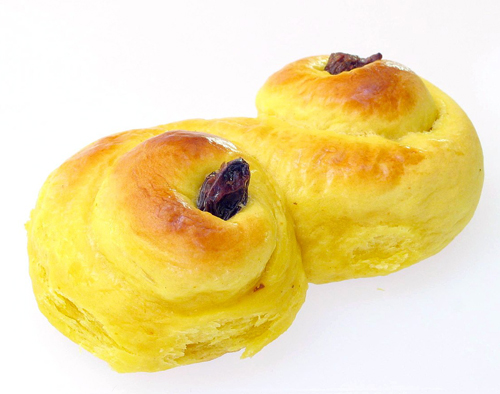
Saffron bun, also called St. Lucia bun (lussebulle)On the first Sunday of Advent, called "Första Advent" in Swedish, many Swedes will put their Advent candles and/or an Advent Star in the windows of their homes. Traditionally the Advent candles are four candles set in a box which is decorated with greenery. One candle is lit on each Sunday during Advent. This custom came from the German Advent wreath. Now often an electric 'stepped' candle display is used instead of real candles.
Advent Stars were first made in the 1930s from red paper. The stars normally have seven (or sometimes nine) points and are about 12 to 18 inches across. They have holes in them and a light is put in them so the light shines out. The stars are hung in a window to remind people that the wise men followed a star to find Jesus in the Christmas story. The stars are now often white and might be made of straw, wood or metal as well as paper. Christmas Eve is also very important in Sweden. This is when the main meal (well, really a feast!) is eaten.
This is often a 'julbord' which is a buffet, eaten at lunchtime. Cold fish is important on the julbord. There is often herring (served in many different ways), gravlax (salmon which has been cured in sugar, salt and dill) and smoked salmon, cold meats including turkey, roast beef, 'julskinka' (a Christmas ham), and cheeses. There is also warm savory foods including kåldolmar (stuffed cabbage), meatballs, 'korv', (sausage), 'jellied pigs' feet, lutfisk (dried cod served with a thick white sauce), 'revbenspjäll' (oven-roasted pork ribs), and boiled potatoes. Another potato dish is 'Janssons Frestelse' (matchstick potatoes layered with cream, onion and anchovies that is baked to a golden brown). There is also 'dopp i grytan' which is thick slices of Swedish rye bread that is dipped in the broth and juices that are left over after boiling the ham.
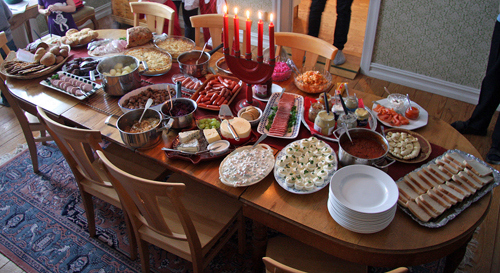
Swedish Julbord
Another popular food at Christmas in Sweden is 'risgrynsgröt' (rice porridge that's eaten with 'hallonsylt' [raspberry jam], raisins or sprinkled with cinnamon). It is often eaten during the evening after people have exchanged their presents.
If there is any risgrynsgröt left over, when it is cold it can be mixed with whipped cream and eaten with a warm fruit sauce. This is called 'Ris a la malta' and is yummy!
Presents are normally exchanged on Christmas Eve. People often go to Church early on Christmas morning.
Another popular and important thing that many Swedes do on Christmas Eve afternoon is to watch Donald Duck! Every year, since 1959, at 3:00 p.m. on Christmas Eve, the TV station TV1 shows the Disney special "From All of Us to All of You" or in Swedish it's "Kalle Anka och hans vänner önskar God Jul" meaning "Donald Duck and his friends wish you a Merry Christmas." About 40 to 50% of the Swedish population stop to watch it!
Like their neighbors in Finland, there was a traditional belief in Sweden that a 'Yule Goat' was connected with the mid winter festival.
In Sweden it was thought to be an invisible spirit that made sure all the preparations were going well. Between Christmas and New Year, men would sometimes dress up as goats and go from house to house singing songs and playing tricks! This is known as 'Julebukking'.
The goat is now mainly seen as a straw ornament that guards the house and Christmas Tree! Straw is used as a decoration in homes as a reminder that Jesus was born in a manger. Christmas Tree decorations made of straw are also very popular.
The Gävle Goat is a traditional Christmas display erected annually at Slottstorget (Castle Square) in central Gävle. It is a giant version of a traditional Swedish Yule Goat made of straw. It is built each year by local community groups at the beginning of Advent over a period of two days.
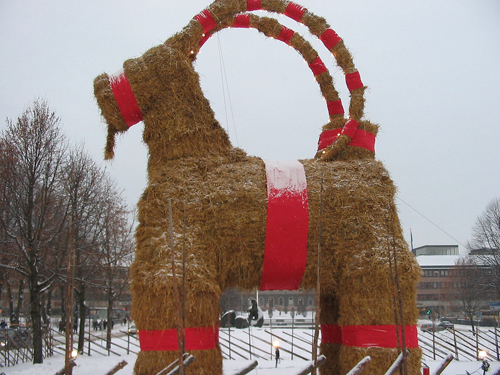
Swedish Gävle goat (Gävlebocken).
Although the display has become notable for being a recurring target for vandalism by arson, most of the time the fire can be extinguished before the wooden skeleton is severely damaged.
If the goat is burned down before December 13, the feast day of Saint Lucia, the goat is rebuilt. The skeleton is then treated and repaired, and the goat reconstructed over it, using straw which the Goat Committee has pre-ordered.
As of 2005, four people have been caught or convicted for vandalizing the goat. In 2001, the goat was burned down by a 51-year-old visitor from Cleveland, Ohio, who spent 18 days in jail and was subsequently convicted and ordered to pay 100,000 Swedish kronor in damages.
The court confiscated his cigarette lighter with the argument that he clearly was not able to handle it. He stated in court that he was no "goat burner", and believed that he was taking part in a completely legal goat-burning tradition.
After he was released from jail, he returned to the US without paying his fine.
In 1996, the Southern Merchants introduced camera surveillance to monitor the goat 24 hours a day. On November 27, 2004, the Gävle Goat's homepage was hacked into and one of the two official webcams changed. One year, while security guards were posted around the goat in order to prevent further vandalism, the temperature dropped far below zero. As the guards ducked into a nearby restaurant to escape the cold, the vandals struck.
During the weekend of December 3-4, 2005, a series of attacks on public Yule Goats across Sweden were carried out: The Gävle Goat was burned on December 3, the Visby goat on Götland burned down, the Yule Goat in Söderköping, Östergötland, was torched, and there was an attack on a goat located in Lycksele, Västerbotten.
The Christmas season of 2006 marked the 40th anniversary of the Gävle Goat, and, on Sunday, December 3, the city held a large celebration in honor of the goat. The Goat Committee fireproofed the goat with "Fiber ProTector Fireproof", a fireproofing substance that is used in airplanes. In earlier years when the goat had been fireproofed, the dew had made the liquid drip off the goat. To prevent this from happening in 2006, "Fireproof ProTechtor Solvent Base" was applied to the goat.
***
Stay informed about the local Swedish (and/or Finnish, Norwegian, Danish, etc.) community by signing up for the free Cleveland eNews mailings. You can select other groups as well. It's easy and free.
Fill out the form for the free Swedish eNews.
***
The cost for the 1966 goat was SEK 10,000. The price tag for constructing the goat in 2005 was around 100,000 Swedish kronor. The city pays one-third of the cost while the Southern Merchants, a group of businessmen, pays the remaining sum. Since 2003 the construction of the goat has been undertaken by a group of unemployed people known as ALU workers.
Since 1986 there have been two Yule Goats built in Gävle: the Gävle Goat by the Southern Merchants and the Yule Goat built by the Natural Science Club of the School of Vasa.
Until 1985 the Southern Merchants held the world record for the largest Yule Goat, but over the years the Natural Science Club's goat increased in size, and in 1985 their Yule Goat made it into the Guinness Book of Records with an official height of 41 ft.
The creator of the original 1966 goat, Stig Gavlén, thought that the Natural Science Club's goat had unfairly won the title of the largest Yule Goat because the goat was not as attractive as the Southern Merchants' goat and the neck was excessively long. The next year there was a Goat war: the Southern Merchants understood the publicity value, and erected a huge goat, the Natural Science Club erected a smaller one in protest.
The Southern Merchants had intended that their huge goat would reclaim the world record, but the measurement of the goat showed it fell short.
Over the following seven years there were no further attempts on the world record, but there was some hostility between the Natural Science Club and the Southern Merchants, evidenced by the fact that the Natural Science Club put up a sign near their goat wishing a Merry Christmas to everyone, except the Southern Merchants.
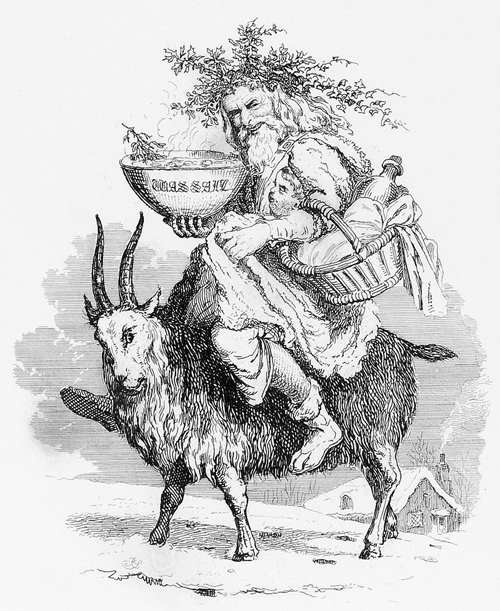
'Old Christmas', riding a yule goat; 1836 illustration by Robert Seymour
The end of Christmas is on January 13th (twenty days after Christmas) which is called 'Tjugondedag jul'. It is traditional to take down and plunder the Christmas tree on Tjugondeda Jul and eat the leftover cookies and sweets from the tree!
***
Want to learn about ethnic and cultural events in Cleveland such as this? Sign up for the free eNews and every Tuesday evening you will receive a free e-mail listing the next week's events. It's easy and free.
Select 'WEEKLY' when you fill out the form for the free weekly eNews.
***
Top of Page
Back to Cleveland Swedish
Back to Holiday Traditions






